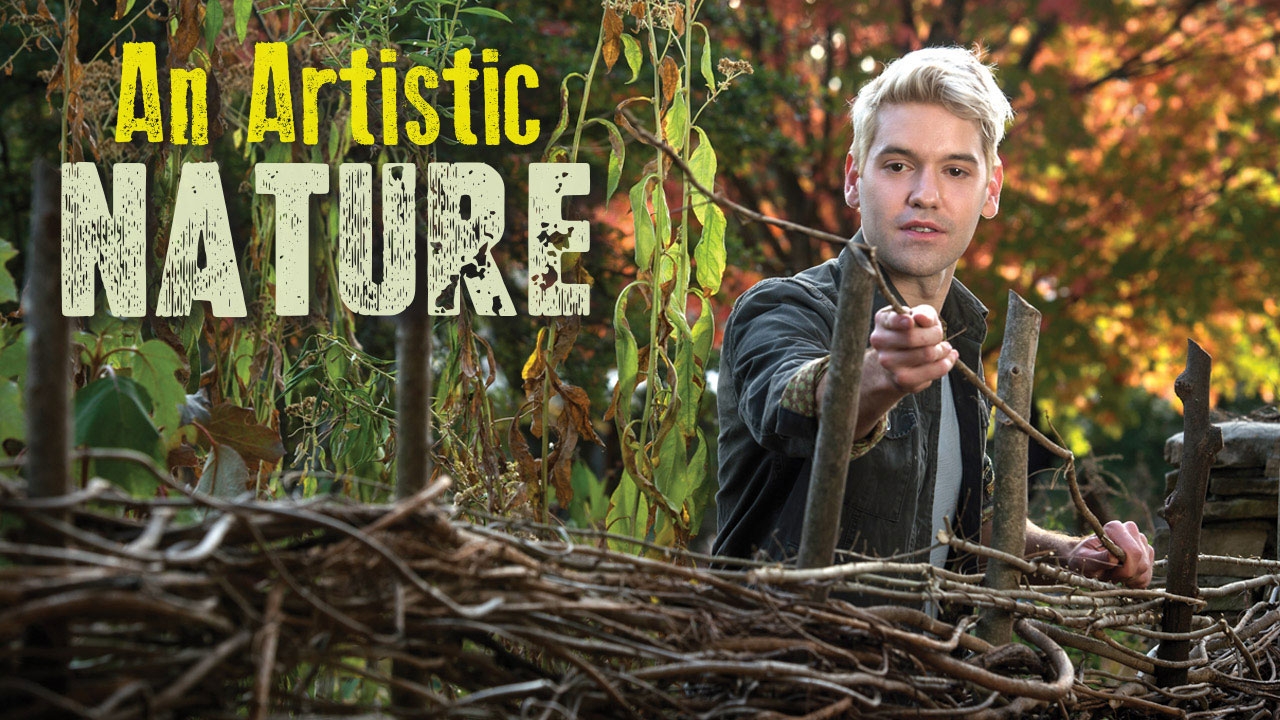Scroll through Jon Woolley’s social media feed, and you’ll wonder if he is living in an animated movie. Snapshots show bright green tree frogs and colorful butterflies alighting gently on his fingers. On starlit nights, moths dance around him, flaunting their Persian-rug patterned wings. A winter’s walk reveals a wonderland of ghostly ice sculptures blooming from plants at his feet.
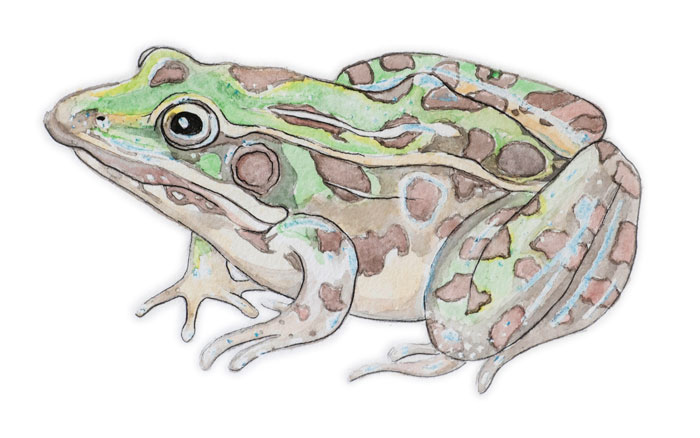 Woolley's watercolors provide a detailed look at mountain residents. (At top) Woolley weaves a border fence out of branches.
Woolley's watercolors provide a detailed look at mountain residents. (At top) Woolley weaves a border fence out of branches.But there is science behind this magic. The wisps of ice, for example, are created by “frostweed (Verbesina virginica),” Woolley writes on Instagram. “When a freeze occurs, the stems burst and make beautiful ice formations at the base of the plants. You have to go out early to see it because the ice sculpture melts quickly.”
Woolley, a 2009 UAB graduate, is the conservation design manager for Birmingham’s Ruffner Mountain nature preserve. That means he’s an artist, gardener, and teacher all in one. But he considers himself an “ecological storyteller” helping people to understand the mysterious realms in their own backyards. “When we observe the creatures sharing our environment, there are bound to be elements left to our interpretation,” he says. “By focusing on the connections where scientific understanding, emotional experience, and imagined realities coexist, I hope to inspire wonder and reverence for the natural world.” However, it’s also important to be honest about nature’s complexity and raw unpredictability. “In an ecosystem, tenderness and brutality coexist without any contradiction,” he adds.
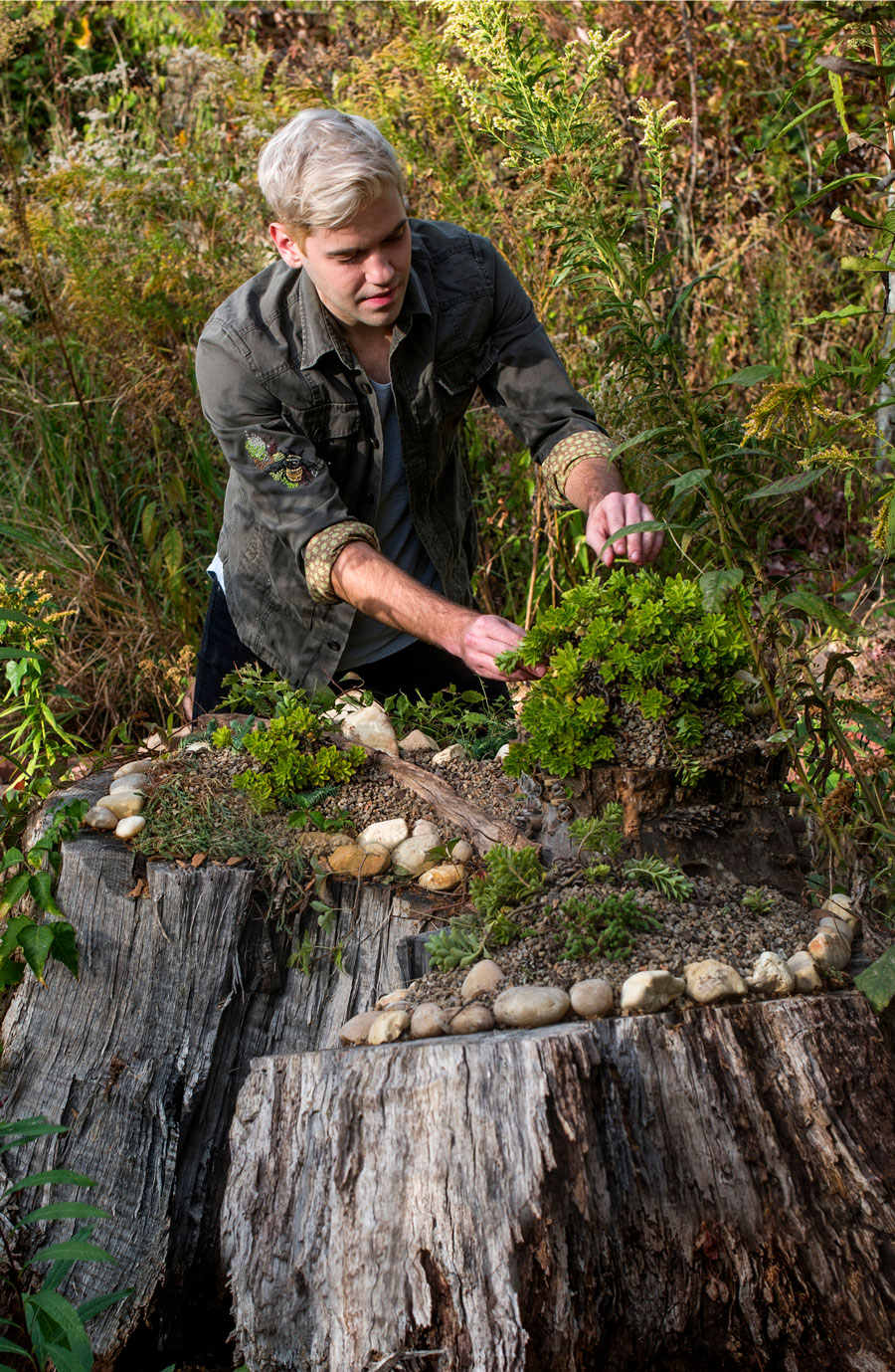 A tree stump becomes the base for a miniature animal kingdom. So far, Woolley has seen chipmunks, snakes, salamanders, and insects using the stump.
A tree stump becomes the base for a miniature animal kingdom. So far, Woolley has seen chipmunks, snakes, salamanders, and insects using the stump.Farm and Forest
Becoming a naturalist was an easy path for Woolley, who grew up amid farms and forests in Sterrett, southeast of Birmingham. When he wasn’t helping his family grow vegetables or tend horses, goats, turkeys, chickens, and honeybees, he was rambling through wild thickets in search of hidden spots where he could sketch animals and plants.
All of that hands-on work and quiet observation taught Woolley much about the rhythms and seasons of life. Still, he arrived at UAB with “so many questions,” he says. “Why do some cultures value sustainable relationships with the natural world more than others? How are these values created and expressed?” The interdisciplinary arts-and-sciences focus of the University Honors Program, part of the UAB Honors College, encouraged him to seek a multitude of answers. So he tailored his major in international studies toward political science, global economics, and applied anthropology. One semester might find him making documentary films and learning about urban planning; in another, he would be growing organic vegetables and flowers at Jones Valley Teaching Farm, a repurposed block in downtown Birmingham. Together, these experiences “helped me connect the dots,” Woolley explains. “I became interested in understanding sustainable agriculture and incorporating nature into urban design.”
Back to Our Roots
The biophilia hypothesis could have been written for Woolley—or perhaps by him. Simply put, it states that nature is a fundamental part of human nature; we are biological organisms with a built-in need to connect with our living, breathing, blue-and-green world.
The rise of cities and technological advances such as air conditioning have done much to sever that connection. The United Nations reports that more than half of the world’s human population now lives in urban environments, with the potential to hit 70 percent by 2050. The average American now spends nearly 90 percent of his or her time indoors, according to the National Human Activity Pattern Survey. And we’re paying a price through chronic stress, anxiety, and poor health, Woolley says.
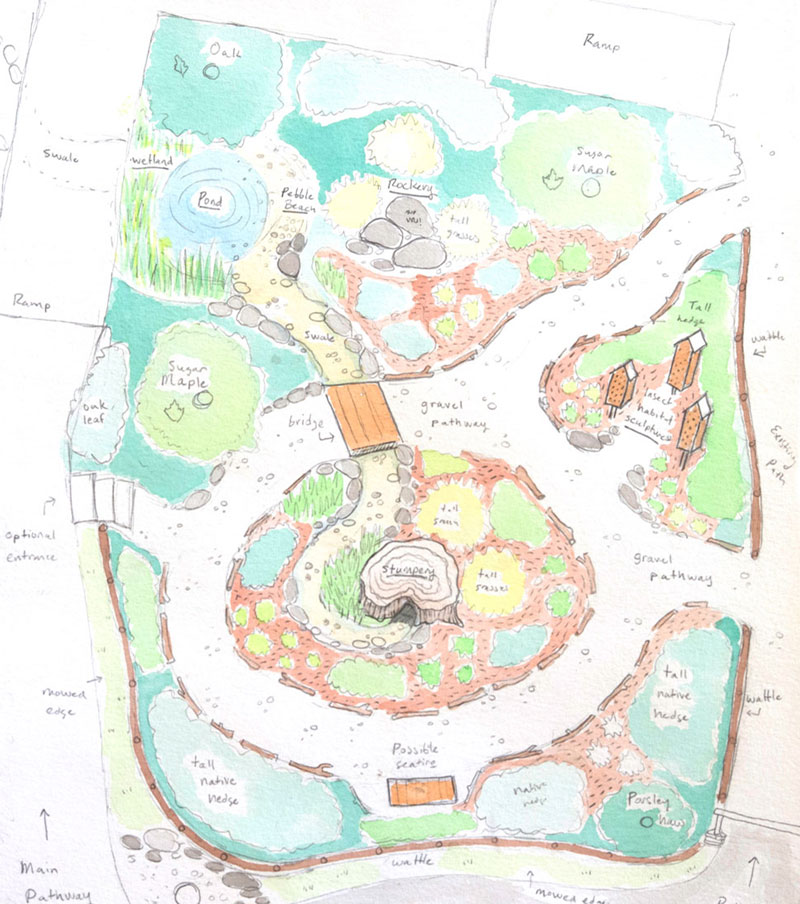 Woolley's habitat garden shows Ruffner Mountain visitors how to fit native plants and animals into their own landscapes.
Woolley's habitat garden shows Ruffner Mountain visitors how to fit native plants and animals into their own landscapes.Biophilic design offers a way to reestablish our roots. It can be as grand as a building designed to incorporate natural materials and sunlight, or something as simple as filling our homes and workspaces with plants. These encounters with nature refresh and nourish us physically, mentally, and spiritually, Woolley explains. “More than 30 years of extensive scientific research shows that connection to natural spaces can elevate mood, reduce stress, promote healing, improve cognitive functioning, increase productivity, and heighten self-esteem.” Children are especially receptive to outdoor exploration, particularly if plants and animals are involved, he adds. “I believe it fosters empathy.”
Woolley gained on-the-ground experience with biophilic design after graduating from UAB. He worked as a garden designer and farm manager in Colorado and North Carolina before returning to Birmingham. Under the name Little Forest, he also has transformed downtown warehouses, storefronts—and even wedding cakes—into green glades. His hand-crafted terrariums resemble jewels containing tiny worlds.
Biophilic design is not a passing trend, Woolley says. Instead, it will become “one of the guiding principles in the future of design. With it, we can create and sustain functional spaces that are inspirational, restorative, and healthy.”
 Illustration of leaf cutter bee by Jon Woolley
Illustration of leaf cutter bee by Jon WoolleyCuriosity As a Teaching Tool
At Ruffner Mountain, one of the nation’s largest urban nature preserves, Woolley applies biophilic design to education. His watercolors in the Nature Center offer a detailed look at mountain residents. Outside, a habitat garden shows visitors how to make room for native plants and animals in their own landscapes. Bordered by a fence made from woven branches, the small, lush spot includes a tiny dirt depression—a puddling pool—where butterflies can sip water. Fragrant mountain mint, tall grasses, and purple coneflowers encircle a tree stump rehabilitated into a welcoming home for wildlife. Woolley designed the garden and continues to expand it with his own hands. He also teaches workshops where the public can help build as they learn.
Then there are the bee condominiums. You can’t miss the biggest one, a whimsical castle floating above the Nature Center. (Its design was inspired by Castle in the Sky, a movie from Japanese anime master Hayao Miyazaki, one of Woolley’s heroes.) Holes in the wooden structure provide homes for solitary native bees while drawing attention to their plight. Like their honeybee counterparts that have been ravaged by colony collapse disorder, the more than 4,000 species of native North American bees are “dying off at alarming rates due to habitat loss and overuse of pesticides,” Woolley reports. That’s unfortunate for humans, because native bees often are more efficient than honeybees at pollinating plants, including fruits and vegetables vital to our food supply. Last year, Woolley collaborated with UAB art students, led by assistant professor of sculpture Stacey Holloway, to build more bee houses out of reclaimed and foraged materials. Those imaginative insect residences now sit alongside Woolley’s work in the habitat garden, where they play a role in Ruffner Mountain’s initiative to understand and cultivate local bee biodiversity.
The title of conservation design manager is a new one—it didn’t exist at Ruffner Mountain until Woolley joined the staff in 2015—but it’s likely to start popping up in more places, he says. “Design is a toolkit for innovation. It builds emotional connections in a complex world.” In other words, vital ecology lessons become much more engaging when they tickle the senses and spark curiosity and wonder. “People protect only what they love,” Woolley adds.
 A neighborhood of whimsical bee condominiums, designed and built by Woolley and UAB art students, houses multiple species of solitary native North American bees, threatened by habitat loss and pesticide use.
A neighborhood of whimsical bee condominiums, designed and built by Woolley and UAB art students, houses multiple species of solitary native North American bees, threatened by habitat loss and pesticide use.
Sanctuaries for Life
Alabama ranks as one of America’s most biodiverse states, with a number of species found only within its borders. At the same time, “approximately one out of every seven species in Alabama has characteristics that make it vulnerable to extinction,” Woolley says. To illustrate those statistics, he points to a rectangular terrarium in his combination office/lab. It holds a skinny, spring-green fern—the Tutwiler fern (Asplenium tutwilerae)—that happens to be one of the rarest plants in the world. It’s found in just one dot of land in Hale County.
By using design to tell the stories of such species and ecosystems, Woolley hopes to nurture a love of place—“to create sanctuaries for biodiversity, but also for ourselves,” he says. “When we observe nature through the perspective of our own lives, we begin to grasp how our well-being is deeply interconnected with the well-being of all organisms.”
After all, even humans and fungi shared a common ancestor 1.1 billion years ago. You’ll find that fact on Woolley’s Instagram, next to a photo of delicate, moon-white mushrooms he constructed out of paper.

Bring Nature Home
Woolley names five easy ways to benefit from biophilic design
1. Share your habitat: “Choose native plants for your home landscape or apartment balcony, and avoid synthetic herbicides, pesticides, and fertilizers. Consider installing a bee condo, bat house, or birdhouse. For details, attend a Ruffner Mountain workshop or look at online resources.”
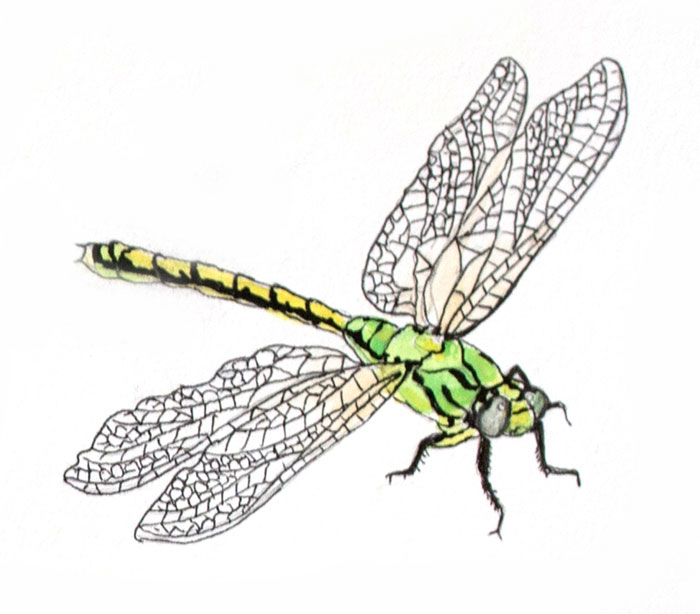 Illustrations of dragonfly and ants by Jon Woolley
Illustrations of dragonfly and ants by Jon Woolley2. Install a water feature: “Help wildlife find water by adding ponds, birdbaths, or puddling pools to your landscape. If you don’t have outdoor space, consider an indoor water feature for your own benefit. Research has shown that the presence of water prompts improvements in self-esteem and mood. Hearing water and touching it also has been shown to reduce stress.”
3. Cultivate indoor plants: “Houseplants reduce levels of carbon dioxide, certain pollutants (such as benzene and nitrogen dioxide), and airborne dust; increase humidity; and keep air temperatures down during summer months. Start with one of the more indestructible species, like Sansevieria trifasciata or Zamioculcas zamifolia.”
4. Let in the sun: “Exposure to natural daylight can help elevate mood and balance the hormone regulating sleep. Research also shows higher productivity in workplaces with quality natural light.”
5. Keep a nature journal: “Documenting my experiences is the best way for me to connect more deeply to the natural world. After a hike, write down your observations and questions. Describe your mood before and after the experience. You also can press leaves and flowers or sketch in your journal. The impression of a landscape is dependent on the emotions of the person viewing the landscape, so by keeping a record, you can piece together a story of a place and gain a deeper understanding of yourself.”
• Discover exciting avenues for academic exploration in the UAB Honors College and the College of Arts and Sciences.
